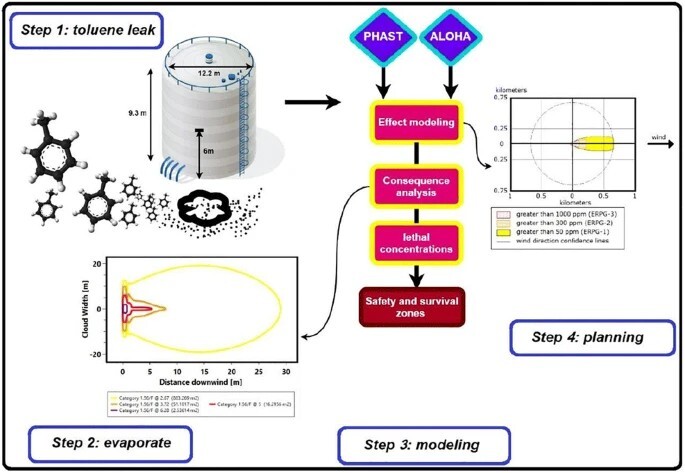Hazards of toluene storage tanks in a petrochemical plant: modeling effects, consequence analysis, and comparison of two modeling programs.
Published in Earth & Environment, Sustainability, and Civil Engineering

Abstract
The leakage of toluene from damaged tanks can threaten both workers and the environment; ergo, the effects and consequences of toluene leaks can be modeled and quantified to aid in emergency planning and response management. This study modeled the effects and consequences on various scenarios of toluene release via the ALOHA and PHAST programs: evaporation puddle formation, dispersion of toxic and flammable vapor clouds, the distribution of lethal concentrations, and the probability of death from a toluene leak from a height of 6 m of the tank wall. The outputs of the two modeling programs were analyzed and compared. The results showed that the maximum threat zone distances associated with high hazards of toxicity, flammability, and thermal radiation of toluene were respectively 736, 132, and 52 m in ALOHA and 1626, no result, and 239 m for PHAST from the accident point in the downwind. The highest probability of death was 92%, which occurred at a distance of 1 m in the cold seasons. The output values for the PHAST program were higher than those for ALOHA. The results also showed that the survival zone in which the probability of death was low could be determined from a distance of 51 m onwards. Although the assessment of the results indicated no matching between the results obtained by ALOHA and PHAST, the program outputs could still help decision-makers in emergency response planning and the allocation of medical and support services during emergencies.
Introduction
This section discusses the environmental and health hazards of toluene, a volatile organic compound. It highlights major industrial accidents related to chemical leaks and explains the importance of modeling tools like ALOHA and PHAST in emergency planning. The objective of the study is to model and compare the consequences of toluene leaks using these two tools.
Materials and Methods
The authors describe the parameters and inputs for modeling, including geographic location, atmospheric data, chemical and physical properties of toluene, and tank characteristics. They explain how effects (e.g., vapor cloud dispersion, fire behavior) and consequences (e.g., lethality, radiation exposure) are modeled using ALOHA and PHAST software. Equations and assumptions for modeling discharge, dispersion, and radiation are also detailed.
Results and Discussion
This section compares simulation outcomes between ALOHA and PHAST for both warm and cold seasons. It covers evaporation rates, vapor cloud dispersion, burn rates, thermal radiation, and probability of death. PHAST generally predicted greater hazard zones and higher lethality than ALOHA. Visual maps and graphs illustrate toxic and flammable zones, evaporation dynamics, and impact distances.
Conclusions
The paper concludes that both tools are useful for emergency planning, but their outputs vary significantly. PHAST produced more conservative (larger) threat zones than ALOHA. The models help define safety zones and support decision-making in hazardous material management. However, differences in modeling approaches suggest that results should be interpreted cautiously.
Follow the Topic
-
Environmental Science and Pollution Research

This journal serves the international community in all broad areas of environmental science and related subjects with emphasis on chemical compounds.
What are SDG Topics?
An introduction to Sustainable Development Goals (SDGs) Topics and their role in highlighting sustainable development research.
Continue reading announcement





Please sign in or register for FREE
If you are a registered user on Research Communities by Springer Nature, please sign in